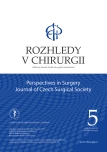“Maximal” minimally invasive thymectomy in patients with Nonthymomatous Myasthenia Gravis – short-term results over a 10year period – retrospective study
Authors:
P. Juhos 1; M. Janík 1; M. Lučenič 1; K. Tarabová 2; D. Šiška 1; P. Lauček 1
Authors‘ workplace:
Klinika hrudníkovej chirurgie SZU a Univerzitná nemocnica Bratislava
1; Klinika anesteziológie a intenzívnej medicíny Lekárskej fakulty Univerzity Komenského a Univerzitná nemocnica Bratislava
2
Published in:
Rozhl. Chir., 2020, roč. 99, č. 5, s. 226-231.
Category:
Original articles
doi:
https://doi.org/10.33699/PIS.2020.99.5.226–231
Overview
Introduction: Thymectomy has always been considered an important treatment modality for patients with Myasthenia Gravis (MG). Because of the absence of randomized trials, its exact role was not clear and was even questioned by some. Indications for surgery were made on empirical basis. It was not until the results of the first randomized double- blinded multicentric study were published, where the combined surgical treatment of patients with nonthymomatous MG was proved superior to conservative treatment alone. In this study the technique of extensive thymectomy via longitudinal sternotomy was used as a mainstay of surgical treatment. In the advent of minimally invasive techniques a variety of options were presented for minimally invasive surgical treatment of thymic pathology.
Methods: The authors present a retrospective analysis of short term results using the slightly modified method of “Minimally Invasive Maximal Thymectomy” developed by Zielinski over a 10 year period (2008−2018). Besides the demographics, we assessed the peri- and postoperative results such as the length of surgery, blood loss, the need for conversion, learning curve impact, the lengths of drainage and hospital stay and the complication rate, both surgical and systemic.
Results: 48 patients underwent surgery using the above mentioned method for non-thymomatous MG. 81.25% (n=39) of patients were diagnosed with a seropositive generalized form of MG, 6 (12.5%) had seropositive ocular form and 3 patients (6.25%) had seronegative form of the disease. The sex ratio profoundly favored females (89.5%; n=43). The median value of the length of surgery was 186,5 minutes, the mean LOS and length of drainage were 4 and 3 days, respectively.
Conclusion: According to our results and experience with Minimally Invasive Maximal Thymectomy, we found it to be an effective and safe method for MG patients after conquering the learning curve.
Keywords:
VATS – nonthymomatous Myasthenia Gravis – Minimally invasive surgery – maximal thymectomy
Sources
- Wolfe GI, Kaminski HJ, Aban IB, et al. Randomized trial of hymectomy in Myasthenia Gravis. N Engl J Med. 2016;375(6):511−522. doi: 10.1056/NEJMoa1602489.
- Deen S, Farivar AS, Louie BE. Thoracic techniques: Robotic thymectomy for thymoma. Indian Journal of Surgical Oncology 2013;4(2):132−137. doi: 10.1007/s13193-013-0211-5.
- Zielinski M, Kuzdzal J, Nabialek T. Transcervical-subxiphoid- VATS “maximal” thymectomy for myasthenia gravis. Multimed Man Cardiothorac Surg. 2005:(425), mmcts.2004.000836. doi: 10.1510/mmcts.2004.000836
- Jaretzki A, Wolff M. “Maximal” thymectomy for myasthenia gravis. Surgical anatomy and operative technique. J Thorac Cardiovasc Surg. 1988;96(5):711−716.
- Sieb JP. Myasthenia gravis: an update for the clinician. Clin Exp Immunol. 2014;175:408– 418. doi: 10.1111/cei.12217
- Oppenheim H. Die myasthenische Paralyse (Bulbärparalyse ohne anatomischen Befund). Edtion ed. Berlin, S. Karger 1901.
- Sauerbruch F. Thymektomie bei einem Fall von Morbus Basedowi mit Myastheine. Mitteilungen aus den Grenzgebieten der Medizin und Chirurgie 1912/1913;25:746−765.
- Blalock A, Mason MF, Morgan HJ, Riven SS. Myasthenia gravis and tumors of the thymic region: report of a case in which the tumor was removed. Ann Surg. 1939;110(4):544−561.
- Nastuk WL, Strauss AJ, Osserman KE. Search for a neuromuscular blocking agent in the blood of patients with myasthenia gravis. Am J Med. 1959;26(3):394−409.
- Masaoka A, Nagaoka Y, Kotake Y. Distribution of thymic tissue at the anterior mediastinum. Current procedures in thymectomy. J Thorac Cardiovasc Surg. 1975;70(4):747−754.
- Zielinski M, Hauer L, Kuzdzal J, et al. Technique of the transcervical-subxiphoid-videothoracoscopic maximal thymectomy. J Min Access Surg. 2007;3:168−172 doi: 10.4103/0972-9941.38911.
- Martinka I, Fulova M, Spalekova M, et al. Epidemiology of Myasthenia Gravis in Slovakia in the years 1977-2015. Neuroepidemiology 2018;50(3−4):153−159. doi: 10.1159/000487886.
Labels
Surgery Orthopaedics Trauma surgeryArticle was published in
Perspectives in Surgery

2020 Issue 5
Most read in this issue
- Early complications in surgery of umbilical and epigastric hernias
- Upper urinary tract urothelial carcinomas – our experience
- Management of oesophageal anastomosis dehiscence after oesophagectomy for oesophageal cancer
- Abdominal abscess associated with salmonellosis − case report
